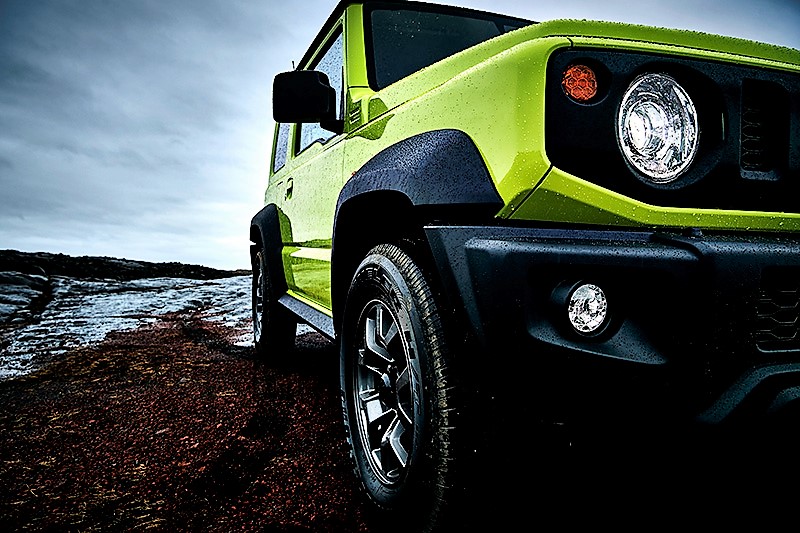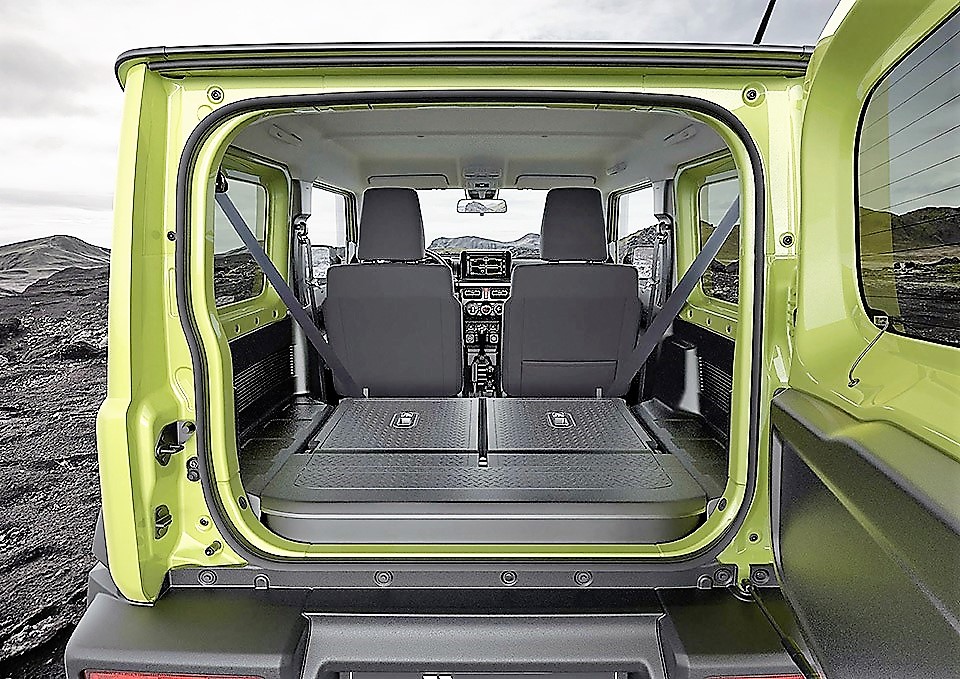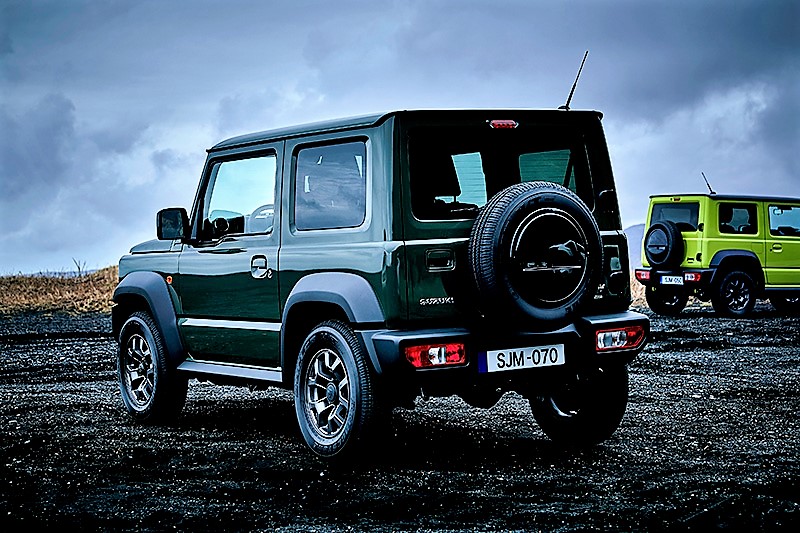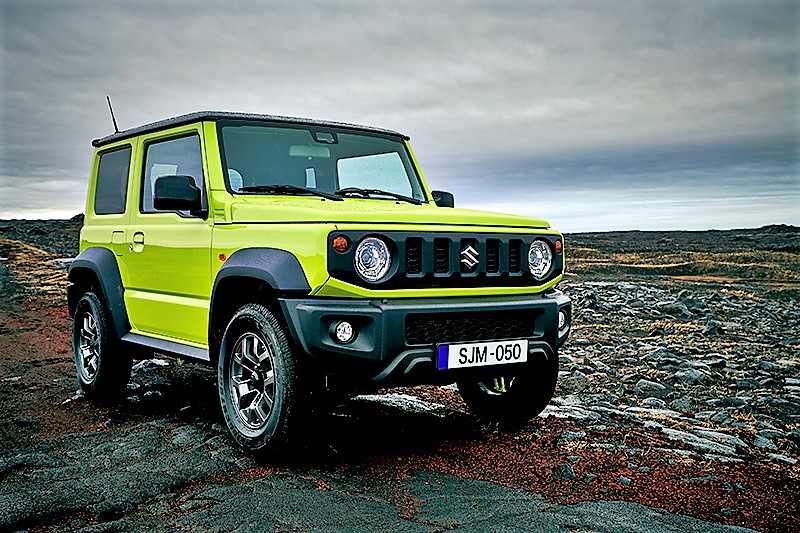Rather unusually, I am going to start this review with a list: dual-sensor brake support, hill descent control, lane departure warning, high beam assist, cruise control, air-con and a CD player (hooray!). You can also factor-in the 1.5-litre four-cylinder petrol engine; 200cc greater than its forebear and now developing a modest 98bhp. That’s what is new for the Suzuki Jimny, the uniquely compact, lightweight and all-wheel-drive, traditional, multi-surface mode of transport.
It is 45mm wider, 20mm taller but 30mm shorter than the outgoing Jimny. However, it retains a body-on-ladder-frame construction, which serves its impressive on and off-road capabilities to perfection. Remove the black wheel-arch extensions, roof panel (with visible guttering) and the chunky five-bar grille and you still have the lovable and widely-appreciated Jimny, in all of its diminutive glory. Yes. It has changed materially; not by much but changed all the same and for the better. It is an ultimate example of more, more and a smidgen less being welcomed eagerly.

To those 4x4 fans that actually venture into off-road environments, which does not mean the flower-beds at Sainsbury’s supermarket, or the grassy verges outside their children’s schools, the Jimny has always been the consummate go-almost-anywhere vehicle. It is admired for its square-rigged design and elements of manoeuvrability that are enhanced vastly by being able to see all four corners of the car from the driver’s seat.
Decent ground clearance and a moderately short wheelbase, with minimal body overhangs front and rear, ensure that approach, departure and obstacle cross-over angles are optimised and uncompromised. The addition of black cladding materials on the outside of the new Jimny is a means by which to avoid incurring panel damage, when working a cross-country route. If anything, it looks significantly more workmanlike and, thus, appealing to the agricultural and other professional communities that have been given the cold shoulder by Land Rover.

If Suzuki GB does not address this latter aspect with positive action, then it will be shooting itself in the automotive foot. It is abundantly clear to any observer that the 10,000 annual registrations of the equally-loved Defender (which is no longer produced) should be a conquest sales target for Suzuki. Even if the Japanese firm manages to grab just 10% of Land Rover’s now open market, it would increase Jimny’s UK footprint by more than 50% and I am darned certain that around a third of a million Pounds additional annual profit would be welcomed by the firm on that basis (working on a premise of around £3k/car/year). In addition, repeat and referred business would keep the figure a consistent one.
In the meantime, funsters and adventurers will be able to revel in the Jimny’s overall competences, as long as the pricing is maintained at a sensible level. While FCD discounts will ensure that pricing remains keen, Suzuki GB needs to ensure that its pursuit of profits does not dent sales potential from the outset. The company was judicious enough to introduce its Swift Sport model at a sensible £16,500 for the first month of placing the car in the market, although the list now starts at a steeper £18,000.

From the inside, the intention is as purposeful as the exterior. The surfaces are all wipe-clean and practical and visible posi-drive screws for the dashboard are given a prominent place. In SZ5 versions, the typical Suzuki touch-screen sits in the centre of the dashboard, introducing levels of connectivity unknown to previous Jimny owners. It is all very civilised and benefits from excellent space utilisation, which includes a boot capable of carrying a bale of hay to outlying fields, or stables, when the 50:50-split rear bench seat is folded forwards. It is utilitarian but comfortable.

Having already mentioned the increased capacity petrol engine, in which torque has been optimised for even better off-road prowess, the Jimny still drives through a four-wheel-drive system, known as AllGrip-Pro, that features a low-range transfer gear-set. While the default setting is rear-wheel-drive high-ratio, the gearbox can be slotted into four-wheel-drive (high-ratio) at speeds of up to 62mph. Selecting four-wheel-drive low-ratio demands understandably a complete stop.

While a largely alien facility to the majority of modern SUV and crossover owners, the low range allows serious mud-pluggers to get stuck in, with a high degree of confidence. Using brake LSD technology, when traction is lost, the transmission shuffles power to the wheels with most grip. It is standard on both UK SZ4 and more luxurious SZ5 trim levels. Incidentally, the SZ5 also receives full LED headlamps, alloy wheels as opposed to steel rims, climate control as opposed to standard air-con, rear privacy glass, the touch-screen that loses the CD player (boo-hoo!), heated front seats and body-coloured door handles.
Improving steering responses, a new damper has been applied to the rack to reduce vibration and kickback. However, the torsional rigidity of the ladder-frame chassis has been increased by around a third, which means that the Jimny’s suspension system can be tailored to provide markedly better on-road performance, to match its indomitable off-road potential. By increasing the diameter of the front anti-roll bar, both ride comfort and stability of the car have been increased. While a five-speed gearbox is standard, a four-speed automatic transmission is also available.

Having outlined glibly the driver and safety aids now fitted to the Jimny, it is worth highlighting that it also has hill hold control, autonomous braking, distance control, high-beam assist, road sign recognition, emergency stop signal (all indicators flash), the latest electronic chassis-stability program, tyre pressure monitoring, six airbags and both impact and pedestrian injury mitigation bodywork. For a car, the roots of which lie in the technology of 1970, the Jimny is bang up-to-date for tomorrow.